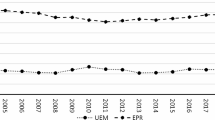Abstract
This paper explores convergence of real health expenses across the Indian states. The new panel convergence methodology developed by Phillips and Sul (Econometrica 75:1771–1855, 2007) is employed. The empirical findings suggest that these states form distinct convergent clubs, exhibiting considerable heterogeneity in the underlying health expenses patterns.

Similar content being viewed by others
Notes
In our application with annual data, the smoothing parameter λ is set equal to 100.
Extensive Monte Carlo simulations conducted by Phillips and Sul (2007) show that r = 0.3 is satisfactory in terms of both size and power.
References
Andrews, D. W. K. (1991). Heteroskedasticity and autocorrelation consistent covariance matrix estimation. Econometrica, 59, 817–858.
Barro, R. J. (1997). Determinants of economic growth: A cross country empirical study. Cambridge: MIT Press.
Barro, R. J., & Sala-i-Martin, X. (2004). Economic growth. New Delhi: Prentice Hall of India.
Bhargava, A., Jamison, D. T., Lau, L. J., & Murray, C. J. L. (2001). Modeling the effects of health on economic growth. Journal of Health Economics, 20, 423–440.
Blomqvist, A. G., & Carter, R. A. L. (1997). Is health care really a luxury? Journal of Health Economics, 16, 207–229.
Bloom, D., Canning, D., & Sevilla, J. (2004). The effect of health on economic growth: a production function approach. World Development, 32, 1–13.
Cole, M. A., & Neumayer, E. (2006). The impact of poor health on total factor productivity. Journal of Development Studies, 42, 918–938.
Deaton, A. (2001). Health, inequality, and economic development. CMH working paper, no.3, Commission on macroeconomics and health.
Deolalikar, A. (1988). Do health and nutrition influence labor productivity in agriculture? Econometric estimation for rural south India. The Review of Economics and Statistics, 70, 406–413.
Dritsakis, N. (2003). A theoretical sample for measuring the optimum inter-regional distribution of health resources. Health Services Management Research, 16, 1–6.
Dritsakis, N. (2005). Health expenditures and gross domestic product: an empirical analysis for member-countries of the European Union with cointegration analysis. Journal of Social Sciences, 1, 66–71.
Duraisamy, P. (1995). Morbidity in Tamil Nadu: levels, differentials and determinants. Economic and Political Weekly, 33, 982–990.
Duraisamy, P., & Sathiyavan, D. (1998). Impact of health status on wages and labour supply of men and women. Indian Journal of Labour Economics, 41, 67–84.
Felder, S., Meier, M., & Schmitt, H. (2000). Health care expenditure in the last months of life. Journal of Health Economics, 19, 679–695.
Fischer, M. M., & Stirbock, C. (2004). Regional income convergence in the enlarged Europe, 1995–2000: A spatial econometric perspective. ZEW discussion paper, no. 04–42.
Gerdtham, U., & Lothgren, M. (2000). On stationary and cointegration of international health expenditure and GDP. Journal of Health Economics, 19, 461–475.
Gumber, A. (1997). Burden of disease and cost of ill-health in India: setting priorities for health intervention during the ninth plan. Margin, 29, 33–72.
Gupta, I., & Mitra, A. (2003). Economic growth, health, and poverty: An explanatory study on India. In R. Misra, R. Chatterjee, & S. Rao (Eds.), India health report 2003. New Delhi: Oxford University Press.
Gyimah-Brempong, K., & Wislon, M. (2004). Health, human capital and economic growth in sub-Sahara African countries. The Quarterly Review of Economics and Finance, 44, 296–320.
Hartwig, J. (2008). What drives health care expenditure? – Baumol’s model of unbalanced growth revisited. Journal of Health Economics, 27, 603–623.
Hodrick, R., & Prescott, E. (1997). Post-war business cycles: an empirical investigation. Journal of Money, Credit, and Banking, 29, 1–16.
Kannan, K. P., Thankappan, K. R., Kutty, C. R., & Aravaidan, K. P. (1991). Health and development in rural Kerala: A study of the linkages between socioeconomic status and health status (pp. 98–105). Trivandrum: The Kerala Sastra Sahitya Parishad.
Okunade, A. A., & Murthy, V. N. (2002). Technology as a “major driver” of health care costs: a cointegration analysis of the newhouse conjecture. Journal of Health Economics, 21, 147–159.
Phillips, P. C. B., & Sul, D. (2007). Transition modelling and econometric convergence tests. Econometrica, 75, 1771–1855.
Phillips, P. C. B., & Sul, D. (2009). Economic transition and growth. Journal of Applied Econometrics, 24, 1153–1185.
Russe, R. (2001). Expenditure on health care in the EU: making projections for the future based on the past. HEPAC, 2, 156–161.
Samudram, M., Nair, M., & Vaithilingam, S. (2009). Keynes and Wagner on government expenditures and economic development: the case of a developing economy. Empirical Economics, 36, 697–712.
Schultz, T. P. (1999). Health and schooling investments in Africa. Journal of Economic Perspectives, 13, 67–88.
Strauss, J., & Thomas, D. (1998). Health, nutrition and economic development. Journal of Economic Literature, 36, 766–817.
Tang, C. F. (2009). An examination of the government spending and economic growth nexus for Malaysia using the leveraged bootstrap simulation approach. Global Economics Review, 38, 215–227.
Vaidyanathan, A. (1995). An assessment of nutritional and health status. Discussion paper, no. 3, UNDP research project. Thiruvananthapuram: Center for Development Studies.
Wang, Z. J., & Rettenmaier, A. J. (2007). A note on cointegration of health expenditures and income. Health Economics, 16, 559–578.
Weil, D. (2001). Accounting for the effects of health on economic growth. Mimeo: Department of Economics, Brown University.
Acknowledgments
We thank Donggyu Sul for making the Gauss code available to us. A sample code can be downloaded from Donggyu Sul’s homepage: http://homes.eco.auckland.ac.nz/dsul013/. The usual disclaimer applies.
Author information
Authors and Affiliations
Corresponding author
Rights and permissions
About this article
Cite this article
Apergis, N. Health Expenses: Evidence from the Club Clustering Approach. Int Adv Econ Res 19, 399–407 (2013). https://doi.org/10.1007/s11294-013-9408-1
Published:
Issue Date:
DOI: https://doi.org/10.1007/s11294-013-9408-1




